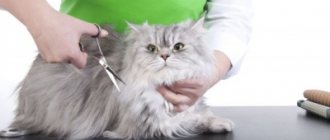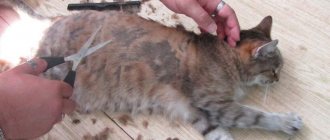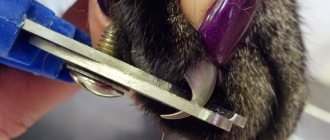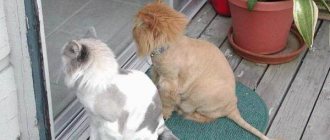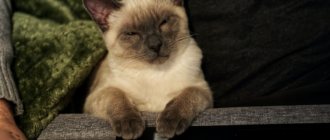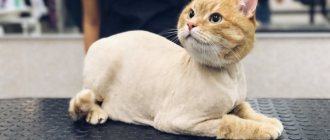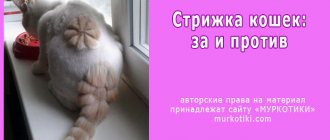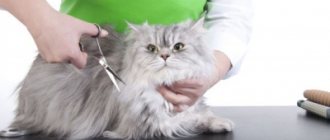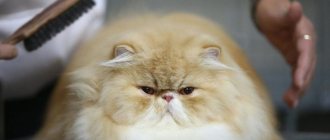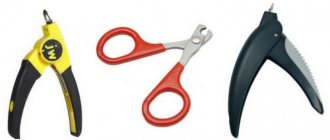In the summer heat, long-haired cats have a hard time. Even their seemingly ideal thermoregulation system cannot cope with cooling the body in conditions of global warming and extremely hot weather.
And a shaggy coat, which is so beautiful in winter, is an extra burden in the heat: the wool and undercoat interfere with normal heat exchange, and the animal literally languishes from stuffiness and overheating. But there is always a solution - you can cut the cat’s hair!
Should your cat be groomed?
Before carrying out any manipulations with your pet, you need to figure out whether it really needs human intervention.
The animal's fur is often perceived by owners as an analogue of a good mink coat, which warms in both winter and summer. Some owners, in a fit of love, want to rid the cat of fur, thinking that this will help him survive the summer heat.
In fact, you need to approach this issue carefully. For example, Maine Coons and other semi-longhaired breeds have undercoats and guard hairs of varying lengths, and their beautiful long coats provide a natural layer that protects them from the heat. Therefore, improper haircut leads to overheating or hypothermia.
In what cases is the procedure indicated?
The truth is, cats don't need trimming regardless of the length of their fur. They know how to take care of themselves - they lick themselves, rub against hard objects, and shed regularly. Experienced owners help the cat take care of itself using special tools, do not skip washing time, and brush it regularly. If this is not done, the animal will need the help of a groomer.
In short, a haircut is indicated only in two cases:
- tangles appeared on the pet’s body;
- The pet is sick and needs access to the skin.
The remaining reasons for which the manipulation is carried out are not mandatory, but may be important for the owners.
- Neat appearance of the cat
- Stomach problems after licking a lot of fur.
- The cat does not allow itself to be brushed or bathed.
- The cat's inability to care for itself (old age or illness).
- Trying to control cat hair allergies.
There are studies that show that allergies are caused not by fur, but by protein from cat saliva, so hair removal will not get rid of cat allergies.
In the salon or at home?
Do you want to cut your cat's hair at home in Moscow? Don’t know where to get a cat’s haircut and how much it costs? Our cat hair salon will give your cat a cheap haircut at home with a free technician visiting Moscow with service like in a salon.
Cat grooming at home is performed by experienced professionals with at least 3 years of continuous work experience. With us you can cut your cat’s hair inexpensively and efficiently in a short time and at a low price of 1090 rubles .
Cat groomers come with their own sterile tools and cosmetics by appointment. All you need is a table and a power outlet. Cat grooming can be done either with a machine or with scissors, at your discretion. Prices for cat grooming and additional services are listed on our website.
Now you know where to get a cat’s haircut at home in Moscow inexpensively and with high quality, without overpaying for a cat’s haircut in a salon and, at the same time, saving a lot of time.
Why do you need to groom your pets?
Cat owners provide their furry friend with balanced nutrition, care and care. To ensure that your purr is always beautiful and healthy, it is important to properly care for his coat. The cat should have clean, healthy fur. But the home beauty cannot always cope with this.
This is especially true for long-haired cats. In addition to other types of hair care, it needs to be cut. And the hair needs to be trimmed not because it grows like a human’s – in length. There are other reasons:
- Long hair gets matted into pellets and tangles. Bacteria, fungi and often infectious ones settle in them, which often cause diseases in animals and humans.
- Wool makes it difficult for the skin to breathe, causing the animal to overheat. This provokes skin diseases and can worsen the general condition.
- A haircut is necessary if there is increased secretion of the glands, including the anal glands.
- When a cat licks itself, it swallows fibers that form balls in the stomach. The animal does not always cough up these balls. Often the gastrointestinal tract becomes so blocked that only a veterinarian can help. One of the common reasons for haircuts is shedding.
- It is difficult for older animals to care for their fur on their own. A haircut will prevent such troubles and protect the cat’s health.
Removing tangles
It is impossible to wash an animal in stubborn tangles or in solid felt. The wool fades, does not dry, and macerations form, causing inflammation of the skin. You cannot pull out tangles - you will cause pain to the animal.
Sometimes oils help to make combing easier and mat cutters (the mat is divided into parts and gradually dismantled). If these options do not help, only a haircut will save the sufferer. The mats are trimmed with a clipper.
Contact only specialists! If you are planning this procedure, do not feed your cat for 6 hours before grooming - in case of using sedatives. Be aware of your cat's temperament.
Experienced specialists, using special fixation and assistants, cut hair without using anesthesia - a haircut that takes 20-30 minutes is not worth it, take care of the health of your affectionate friend! Relief from tangles occurs already on the table during the grooming process, and many cats patiently endure this procedure and are grateful in their own way.
Types of haircuts
There are three types of haircuts. I propose to look at each type in more detail to understand what procedure your cat needs.
Medical haircut
This procedure is necessary if your pet becomes ill or undergoes medical intervention.
For example, if a cat has shingles, it needs to be trimmed to keep it safe and ensure quality treatment. Read about how to treat lichen in cats in my other article.
When you submit your cat for sterilization, doctors will definitely cut off some of the fur before the operation. Similarly, the cat's fur is trimmed or shaved before the IV is inserted.
This procedure is carried out according to indications and can be done directly in a veterinary clinic.
Hygienic haircut
To maintain the pet's hygiene, a hygienic haircut is performed. Its main purpose is to remove tangles and restore wool.
If you are unable to devote enough time to taking care of your pet’s hygiene, you should regularly visit the groomer and bring the animal for procedures that will further simplify caring for the cat.
Removing tangles is very important. Dirt accumulates underneath them and bacteria and parasites can multiply.
You can cut your cat’s hair for hygiene purposes at home, if you have the necessary tools and have mastered a simple technique, which will be discussed later.
Model haircut
This type is carried out solely at the request of the owner. Some people like it when their pet attracts attention due to the unusual shape of its coat, while others combine hygiene procedures with aesthetics.
Some owners get a model haircut before a photo shoot with a cat or do it several months before the exhibition.
Why and how often should you cut your cat's hair?
The most common reason why cats are cut is the owner's desire to give the animal an unusual look. Model pet haircut is one of the modern fashion trends. Cats are also given a haircut before participating in professional exhibitions. Some owners believe that cutting their furry pet's hair is necessary in order to relieve it of discomfort in hot weather.
However, shortening the fur due to heat is not practical for many felines. The coat of cats is a kind of regulator that helps with excess heat and cold. Persian cats are most often affected by hot weather. However, cats are cut for other reasons:
- Fur stains that cannot be removed by bathing. The pet can get dirty with machine oil, paint, and building materials. In some cases, the animal's fur needs to be shaved.
- Formation of tangles that cannot be combed out. Sometimes shedding occurs so intensely that the owner does not have time to remove the fallen fur. The tangles cause discomfort to the animal, and chafing and rashes can form underneath them. Pieces of fur can get into your pet's stomach when he tries to lick them, which will lead to the formation of hairballs in the stomach.
- The animal is not able to care for its fur. If the pet is weakened, long hair will contribute to overheating.
- Long intense molting. A haircut will make it easier for the owner to care for the pet. Often they resort to eliminating long hair when a baby appears in the house. Lost hairs can rise into the air and settle on children's objects.
- The need for medical procedures. When treating dermatitis, burns and other pathologies, it is sometimes necessary to apply ointments and creams. Long hair will prevent this. Also, after a haircut, it is easier to observe the results of therapy.
The frequency of haircuts depends on the reason for it. If the coat is shortened for decorative purposes, the procedure is carried out 2-3 times a year. To eliminate the risk of overheating, haircuts are done in the warm season.
If the animal is weakened, the procedure is carried out as the hair grows back. The rate of coat renewal depends on the breed of the cat. On average, the process takes 3–6 months.
[custom_ads_shortcode2]
How to prepare for a haircut
Before starting the procedure, choose a place for it - a spacious, flat surface. It is best to use a kitchen table. Remove all unnecessary items from it.
Enlist the help of an assistant. It is difficult to carry out the procedure alone, since it is quite lengthy. Stock up on treats for your pet.
Prepare the necessary tools:
- Trimmer for hard-to-reach and intimate areas.
- Scissors with blunt ends or a tangle cutter.
- Thinning scissors.
- A clipper (if the cat has long hair, you need a powerful electric clipper, at least 45 W).
I also recommend preparing the following materials:
- a thick towel to wipe the cat;
- a disposable diaper in case of an unexpected bowel movement;
- gloves for yourself and your assistant;
- thin comb and brush for combing;
- softening conditioner for combing;
- lubricant for the machine.
Preparing your pet for the procedure
Preparing the cat for the procedure:
- Bathing. It is carried out with a mild shampoo and conditioner to facilitate combing and eliminate the electrification effect. Held a few days before the event.
- Trimming claws. It is necessary to cut off the sharp ends so that the cat does not scratch the performer during the procedure.
- Removing hair around the nipples. The coat should be carefully trimmed with sharp scissors or shaved. Manipulation will prevent injury to sensitive areas during cutting.
- Trimming mats. It will not be possible to trim the stray clumps with a clipper, so you need to remove them before starting the procedure.
- Introducing the animal to the tool. You need to move a short distance from your pet and turn on the machine. He will understand that the sound is not dangerous and will behave calmer.
[custom_ads_shortcode2]
Important rules to know
Before starting the procedure, read the rules for its implementation.
- The paws, tail and head are never cut to zero. There are receptors there that allow the pet to navigate in space.
- The longer the machine runs, the hotter it gets. The cat may get burned.
- Do approaches for 10-15 minutes and take breaks, giving your pet time to rest.
- Leave at least 3 mm of fur on the skin, and preferably 1-2 cm.
- Do not press the blade close to the animal's body, as this may injure it.
- Be sure to lubricate the blade so it glides through the fur rather than tearing it.
- 2-3 days before the procedure, bathe your pet (read how to wash a cat in a separate article). However, if there are mats on your body that cannot be removed, postpone bathing.
Which machine is recommended to choose for grooming a cat?
Currently, the choice of professional tools for grooming furry pets is huge: some owners are trying to save money and purchase the cheapest option. This is their mistake: an inexpensive trimmer will painfully pull out hairs or burn delicate skin, in addition, such models quickly become unusable.
If you need to remove hairs in hard-to-reach places, it is recommended to choose a small trimmer whose blades do not exceed two centimeters in length. Such devices are designed to treat the muzzle and ears; they can be used to remove excess hair under the tail. This is an auxiliary tool that is needed for a thorough haircut, for example, before exhibition events.
For thicker coats, a powerful machine with wide blades is suitable, which can remove even balls of matted fur from Persians. At the same time, it is important that the manufacturer carefully sharpens the blades, otherwise after each manipulation the machine will have to be returned to the master.
The power of the device for Persian breeds should be 45 W or more. Machines with less power simply will not cope with thick hair; they will overheat and break during the first procedure. If your animal has short hair, you can get by with the 20 W model.
It is recommended to purchase an option with the ability to automatically adjust the blades without the need to replace them. In this case, the minimum length of the blades is 0.5 mm (which means that after cutting with such a clipper, the length of the animal’s hair will be approximately 0.5 centimeters). Buying products with small blades is dangerous, because at home, without sufficient experience, you can simply injure the animal.
The best option is a machine that runs on electricity, since the batteries run out quickly, especially when working for a long time with breaks (for example, if you are distracted by conversations and calming actions).
Don’t forget that the trimmer should be as silent as possible (you can check this when purchasing by comparing the performance of several models), and also fit comfortably in your hand. You should not choose devices made of too slippery and heavy material, in which case you will not be able to carry out a quality haircut.
Before purchasing, turn the device on and off several times: during operation, it should not get very hot, otherwise you will have to constantly take breaks, and this is not very convenient.
Step-by-step instruction
It is possible to perform a simple haircut on an animal at home. The main thing is to prepare properly and know the simple rules. Wear thick gloves and have your assistant do the same. Place a towel at hand (in case you need to wipe the cat), tools, peroxide and cotton wool.
- Secure the cat on the work surface. It is best if the pet lies on its side. Your helper should press the cat's back and front paws to the surface.
- If you have not yet gotten rid of tangles, the time to do it is now. Try to separate the lump into fibers, which you then need to comb with a fine-toothed comb. If the tangle is large, cut it out with a tangle cutter or blunt-tipped scissors.
- Before grooming, comb your cat well and use a conditioner spray to remove any tangled hair and make the procedure more comfortable.
- After this, take small scissors or a trimmer and carefully go through the genital area, armpits, nipples and between the fingers.
- When the difficult stage is completed, take up the machine. Use a 3mm or larger comb and cut the fur first on the sides, then on the back and finally on the belly. Follow the growth of the fur. Lubricate the attachment with blade spray as needed.
- You can trim the fur on the paws with scissors.
- If desired, you can use thinning scissors at the end of the procedure.
If you see that your pet is tired or nervous, take a break, calm him down and give him a treat.
I really liked the video about how to groom a cat at home, where the author clearly shows how you can cope with this difficult task in 15 minutes. I hope it will be useful to you too:
How to remove excess hair at home?
If you decide to take an animal into your home, you will have to take care of it, keep it clean, and feed it nutritious food. Most often, cats appear in families, which themselves are gentle and affectionate animals, and it is a pleasure to play with them.
If the owners are new, they have many questions about caring for their pet, for example, the rather pressing topic of keeping the fur clean and which cat breeds need to be trimmed.
And concern immediately arises regarding the question of how to trim a cat’s hair at home.
After reading this article, you can make sure that the procedure does not present any difficulties. Ridding an animal of excess hair is the key to a healthy pet.
Cats with long, fluffy hair most often need a haircut, because these animals shed much more than short-haired cats, and hairballs also constantly roll up, causing a lot of inconvenience. And in this case, the decision to trim the cat is a necessity; you just need to understand how to carry out this procedure yourself at home.
I would like to note that getting rid of excess hair from an animal is not only a guarantee of cleanliness and the absence of hairs throughout the house, but also a guarantee of a healthy pet.
Cats constantly lick their fur, so the hairs penetrate into the stomach, and if this happens constantly, whole balls of hair begin to collect.
In general, cats are able to regurgitate the collected fur, but this is not always possible, and as a result, obstruction of the gastrointestinal tract occurs. Therefore, a haircut is a necessary event.
To trim a cat, you need to prepare yourself and prepare the animal. There are specialized veterinary clinics that provide hairdressing services for animals, and if it becomes a problem for you to do the haircut yourself, you can always turn to specialists, but the procedure will cost money.
What is used to groom cats?
A hair clipper is most convenient for the procedure. This device, unlike scissors, is easy to use and cannot cause injury to your pet if used correctly. The only drawback is the sound of the machine running, which can greatly frighten the cat, and this will create certain problems during the grooming process (the animal begins to struggle and scratch).
If you are even afraid to imagine how to trim a cat at home, then you better turn to a professional. Some veterinary clinics use anesthesia for overly exuberant cats, but this is very dangerous for older cats.
At home, it is difficult to trim a cat for participation in exhibitions, but it is absolutely possible to do this for hygienic purposes.
It is advisable for the clipper to operate quietly. For convenience and ease of cutting, the first step is to choose a high-quality model of the device, preferably not too loud and, of course, not the cheapest.
The stores offer mechanical (manual) and electric machines. After studying all the pros and cons that the sales consultant can tell you about, you will be able to choose the most convenient option.
How many times a year should the procedure be performed?
On average, depending on the breed and age, a cat's fur grows back to its previous size 3-6 months after shearing. It is recommended to trim your cat's hair several times a year.
It is advisable to trim your cat before the summer season, because animals, especially shaggy ones, endure the hot season too difficult, therefore, by learning how to carry out the procedure at home, you will help your cat cope not only with intestinal disease, but also make her feel better in conditions that are too high air temperature.
Result
Is it possible to cut a cat's hair without causing any changes, and how will cutting it at home affect the pet's behavior?
Almost all long-haired breeds change coat color, becoming darker or lighter. It happens that haircut significantly affects the growth of fur, sometimes this process accelerates, and in some cases, on the contrary, it becomes slower, and in rare cases it stops growth completely.
Is it possible to do your hair yourself?
To understand how to properly trim a cat at home, you need to prepare:
- a convenient place, it can be a table or an ironing board;
- a comfortable comb;
- small scissors;
- a special hair clipper;
- hydrogen peroxide and iodine (for treating wounds, if any appear).
Sequencing:
- Initially, you should shorten your cat's claws. For this, manicure scissors are usually used: firstly, this tool can be found in every home, and secondly, high-quality scissors will help you deal with claws without unnecessary problems; If you wish, you can purchase a special device at a pet store - a nail clipper, which is easy to use, and its cost is quite affordable.
- Before you start trimming the nails, you need to disinfect the tool, usually using alcohol. Next, you need to take your pet’s paw in your hand and lightly press on the pad, after which the cat will release its claws, at this moment, without removing your fingers from the pad, begin the procedure of cutting the claws; To complete the procedure, it is recommended to use a nail file to file off the sharp ends.
- For the first time, it is better to trim a cat at home, with the help of a person who will help you hold the animal correctly, and, as a rule, it is much easier to cope with the procedure together. So, the partner, having laid the cat on its side, must hold its limbs.
- If the animal begins to behave quite aggressively, it is better to use a plastic collar.
- Next, they trim the cat with a clipper, starting from the sides, the main thing is not to worry and try not to shake your hands, because an animal that behaved calmly, sensing the owner’s excitement, can show both anxiety and aggressiveness, and then you will no longer be able to do the procedure at home.
- After the sides, the back and belly are trimmed; Particular attention is paid to the abdominal area where the nipples are located.
- It is possible to cut the hair both in the direction of hair growth and against it.
- If the haircut is carried out with an electric clipper, you need to remember that the nozzle must be at least 3 mm.
- In order for everything to go without injury to the animal, you should trim the resulting lumps on the cat with scissors during the procedure, since using a clipper at home this will be impossible and quite unpleasant for the pet itself.
- During grooming, the animal's skin must be stretched to avoid cuts.
- When cutting hair at home, the head, paws at the ends and tail are usually left untouched; this haircut will look like a lion's.
- If necessary, you can use thinning scissors to go through the untrimmed wool.
- When the whole procedure has come to an end, the cat is washed with clean water, or bathed with shampoo and dried with a hairdryer.
Separately about the British cat
The British breed is a short-haired breed, so it is customary to care for the animal’s fur without cutting it. Short hair does not mat in clumps, so there is nothing to cut.
To keep your cat looking neat and well-groomed, use soft brushes to comb its fur. Usually these are rubber or bristly brushes that are not capable of damaging the integrity of the animal’s skin.
And, of course, the British are periodically bathed with a special shampoo, because cleanliness for cats is a guarantee of good health.
Information about Persian cats
Cats of this breed are quite impressionable, so before starting the procedure, it is better to first find a video on the Internet on how to trim a Persian cat at home.
Persian cats have a haircut similar to that of a lion. To groom cats of this breed, it is better to involve assistants who will help calm the animal. For Persian cats, they use a haircut similar to that of a lion - the head, tail and paws are left unchanged, this is a classic hairstyle for representatives of this breed.
Source: https://www.tinydog.ru/koshki/kak-krasivo-podstrich-koshku-v-domashnix-usloviyax.html
What to do if the cat is aggressive
When it is possible to prepare for stressful manipulations, it is better to do so. If you know that your pet will be aggressive, take care of his comfort and your peace of mind in advance.
You can put a protective collar on your cat to protect him from being bitten.
According to the doctor's indications, you can give herbal sedatives in advance to make the process easier.
If the condition of the fur is deplorable, there are tangles, and the cat is wild - only in such cases is anesthesia used. This is done on the basis that anesthesia will cause less harm than the existence of tangles with accumulated dirt and parasites. This procedure is carried out only in the clinic under the supervision of a veterinarian!
Reasons and frequency of haircuts
Cats need to be trimmed from time to time for several reasons. Most often, this activity should be carried out with animals that have long hair, due to its constant rolling into clumps, which cause numerous inconveniences. Cat haircuts can have different purposes:
- For hygiene purposes. In this case, the process is necessary due to the wool becoming tangled and matted. The animal may get too dirty, and the type of contamination will be paint products or certain building materials that cannot be removed with shampoo.
- In certain situations, the fur of very old or sick cats that are unable to take care of their “fur coat” is shortened. This procedure prevents the formation of hair balls in the stomach, which often cause intestinal blockage. It is also necessary in conditions of elevated air temperatures, when there is a risk of overheating of the pet.
- Due to prolonged molting. In this case, cutting will make keeping the animal much easier.
- For medicinal purposes. For certain diseases of cats, haircutting may be recommended by a veterinarian. Indications for such a procedure are usually infectious skin diseases, dermatitis, the appearance of various parasites, as well as hyperplasia of the sebaceous glands. Trimmed wool makes it possible to treat the skin with medications more effectively, and this significantly shortens the treatment process.
- Decorative haircuts. Such hairdressing services for pets are nothing more than a whim of their owners. With the help of a model haircut, owners try to emphasize the individuality of their pet and the characteristics of its character.
- Exhibition haircuts are designed to demonstrate the standards of their breed in animals.
The frequency of procedures associated with shortening hair depends on the intensity of its regrowth. This usually takes from three to six months, depending on the breed of the pet, its health condition and age. On average, it is recommended to provide cats with such hairdressing services no more than two or three times a year.
Removal of tangles should be carried out as they appear.
Model haircuts can be performed more often, but in this case the health of the animal, the condition of its coat, and the season of the year should be taken into account. Therapeutic and hygienic haircuts are usually carried out as needed.
What to do after a haircut
After the procedure, calm the animal down and give it a treat. You need to wipe the cat with a towel and comb it. If possible, bathe the animal and dry it properly. Be prepared for the fact that after the procedure the hair may change structure.
The pet's behavior may also change: a vengeful animal may take a shit, a timid animal may hide in dark places. If a cat is hiding in a warm place, it means she is cold. Help get through the fur growth period by dressing your cat in warm clothes and keeping his resting area warm. For the next cut, take note that the previous length brings discomfort to the cat.
What tools will you need?
Cat hair is thin and thick, so simple scissors and clippers will not work for human hair. The cat grooming tool is selected from among the specialized grooming tools:
- Combs: flat metal comb, slicker brush (without droplets);
- Thinning scissors (mostly) or straight with rounded ends;
- Animal shaving machine and suitable knives;
- Hairdryer with high power (with the ability to turn off the heating);
- Claw cutter;
- You may need fixing accessories (if the cat is not giving in).
To groom pets, you need a special tool.
An important element of cat grooming is the table. The person who shears the animal must approach it from any direction. The rubber, non-slip surface will provide convenience and safety.
If a person has to bend over too much during the process, pain in the back and neck begins. In addition, the table should be well lit. If there is no special table for groomers at home, use another stable table with a non-slip mat on it.
If owners are afraid to cut their cat's hair, a normal haircut will not work. Animals feel fear and aggression and resist.
Recommendations from experts
The procedure for grooming domestic cats is a last resort; as a rule, it is resorted to due to the systematic formation of mats or the need for treatment based on medical indications. In most cases, animals with long hair undergo a similar process.
To prevent pets from getting tangled, it is recommended to comb them with special devices: a slicker brush and a furminator. In addition, animals need to be washed using high-quality products that help maintain the well-groomed condition of their “fur coat”. Such actions not only have a beneficial effect on the health of animals, but also relieve their owners from scraps of fur scattered throughout the house.
You should know that if someone in your household is allergic to a pet’s fur, cutting the pet’s fur will not help. This is explained by the fact that in this case the reaction of the immune system is caused directly by the skin secretions of the animal, as well as by its saliva preserved on the hair.
The coat of cats belonging to semi-longhaired breeds not only protects them from the cold, but also prevents overheating. This type is not inclined to form tangles and only needs regular bathing and combing. This applies to species such as Maine Coon, Norwegian and Siberian cats.
Persian breeds have thin and delicate fur, which after shearing is restored much easier than that of their counterparts. Persians have a very difficult time withstanding hot weather , so their coat is often shortened.
What is meant by grooming and why is it needed?
Grooming refers to a whole range of activities necessary to care for an animal:
- Nail trimming.
- Combing wool, untangling matted areas.
- Grooming of domestic cats, especially long-haired breeds.
- Ear cleaning.
- Eye care.
- Trimming the fur between the fingers.
- Removing tartar and generally caring for your pet’s entire oral cavity.
- In some cases, grooming includes cleaning the anal and other glands.
The word comes from the ancient designation “groom” - a person whose profession was caring for an animal, primarily a horse. Nowadays, the term has passed on to any “hairdresser” for animals, and the professional himself is more often called a “groomer.”
Model haircut "French Lion"
Creative grooming
If everything is clear with traditional types of grooming (pet, professional), then creative grooming deserves more attention.
This is a real art, which not every specialist masters, since, in addition to professional qualities, he must have considerable imagination and artistic talent.
Creative grooming, of course, sometimes goes beyond all limits. But here the master clearly tried to make the dog positive
The most popular ideas are cutting patterns and pictures on the pet's body, creating tattoos, pedicures, dyeing wool, piercings and decorative jewelry.
The prices for these services are quite high, but it is definitely worth it.
Cutting patterns occurs as follows:
- First, a pattern or picture is thought out. A true professional can complete almost any idea - from a popular foot to an entire painting.
- Next, special paints are applied to the skin.
- Trimming. Large pictures require a lot of time and effort.
Tattoos on the body of an animal look no less creative, although they are much easier to do. Transfers are simply applied to the prepared skin of the pet.
They are worn for about 3-4 weeks and are completely harmless to the dog’s health.
Golden “socks” on the paws, decoration on the neck and patterns in the form of leaves – what’s not to say about the autumn mood?
Dog pedicures are far from new in pet salons. For this purpose, special grooming cosmetics are used.
For example, the varnishes used to cover a dog’s claws do not contain solvents and are therefore safe for health.
And what? Bright colors are in fashion now
Piercing is a new procedure, but has questionable reviews.
After all, it would seem that ear piercing is harmless and is suitable for almost all breeds, but the animal can injure itself if the jewelry gets caught in a corner or some object.
The cheapest option is to use various decorations. The most common examples are bows, braids, and hairpins on Biewer Yorkies.
Grooming and its types
The goals of grooming vary. Some owners prepare their dogs for an exhibition, others want their dog to be known as a “neat guy,” and still others want a creative and extraordinary appearance for their pet. Depending on the intent of the cosmetic procedures, there are several types of grooming:
- Hygienic.
- Home.
- Exhibition.
- Creative.
Hygienic. Includes a hygienic haircut (cutting hair in the groin and under the tail) once every 2 weeks - 1 month. It is advisable to do it before swimming. After trimming, it will be easier for the owner to care for the animal. In this case, a haircut along the body is not expected. This method of cutting hair is suitable for dogs in several situations:
- If the dogs belong to breeds that do not need a full haircut. These include both fluffy varieties: huskies, huskies, shepherds, and smooth-haired animals: Dobermans, Dalmatians, bull terriers.
- If the dog is not yet fully grown after the haircut, but needs light hygienic care. Some breeds undergo this procedure between haircuts to always remain well-groomed and look great. Such “dandies” include: poodles, Scotch terriers, Spitz, Pekingese.
- If the animal constantly participates in exhibitions. Accordingly, it requires regular hygienic care between haircuts. Most often this applies to breeds with full-length hair - Maltese, Shihtzu, Yorkie.
In addition to the “sanitary” haircut, hygienic grooming includes a set of standard procedures: cleaning the ears and removing excess hair from them, cleansing the eyes, teeth, trimming the nails. Much attention is paid to the paws. Excess hair is trimmed between the toes and pads, and the hair on the limbs is shortened in a circular manner.
Grooming and its types
Home grooming has one important feature. Its main goal is to give the dog a neat appearance, make it visually attractive and clean. In this case, it is not necessary to adhere to the breed’s conformation standards. A haircut is done more for the sake of hygiene and convenience, rather than for exhibition “beauty”.
Exhibition. But for this type of grooming, the entire procedure is performed strictly according to established rules. Moreover, when making an exhibition version, the master strives to maximally emphasize the advantages of the exterior, and, of course, tries to make the disadvantages of the four-legged appearance invisible. But all these manipulations are carried out in accordance with the requirements of the breed.
Creative. There are not and cannot be any rules, norms or restrictions. After all, when ordering such a service, the owner wants to give his dog’s exterior the most extravagant look. This is done mainly through original curly haircuts, when intricate patterns are cut on the animal’s fur.
There are other techniques through which groomers manage to turn even an ordinary dog into a work of art: dyeing the fur, adding decorative elements - rhinestones, feathers. Some experts are so keen on the creative option that they create dogs that look like pandas, dragons, dinosaurs and cartoon characters.
Main nuances
Cat owners should be aware that not all animals can have their fur trimmed. The restrictions may be influenced by the following factors:
- Color-point or typing type of color. In this case, the regrown hair on the belly and back will be darker in color than before the haircut.
- Unbearable character and increased activity, when the pet cannot be brought into a calm state. In such a situation, you can use anesthesia, but first you need to take into account all the possible risks. Narcotic drugs can cause cardiac arrest, put you into a coma, and contribute to the failure of the kidneys and liver. If there is no other solution, anesthesia can be replaced with sedatives or muscle relaxants. But such an idea must be approved by a veterinarian, and drugs must be administered strictly under his guidance.
- It is not recommended to cut short-haired cats unless absolutely necessary, since in the heat their vital functions are not disrupted and tangles never form. Grooming of such breeds is only relevant in extreme situations, for example, if the animal is soiled with oil paint.
When planning to cut your cat's hair, you should be aware that the structure of its fur, length and color may change, and the regrowth process usually takes several months. It is forbidden to cut the hair on the animal's head, on the pads of the paws and in the inside of the ears.
